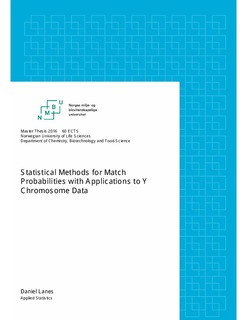| dc.contributor.advisor | Egeland, Thore | |
| dc.contributor.author | Lanes, Daniel | |
| dc.date.accessioned | 2016-08-10T12:51:02Z | |
| dc.date.available | 2016-08-10T12:51:02Z | |
| dc.date.issued | 2016-08-10 | |
| dc.identifier.uri | http://hdl.handle.net/11250/2398684 | |
| dc.description.abstract | Accurate estimates of Y-STR haplotype frequencies is an interesting problem in itself, but is especially important in forensic genetics, where the frequencies are used to calculate the likelihood ratio (LR) for the evidential weight of a DNA profile found at a crime scene.
In this thesis, four methods for Y-STR haplotype frequency estimation are compared with respect to accuracy and bias. This is performed on data from simulated from Wright-Fisher populations with empirical mutation rates and different sampling factors like sample size and the number of markers comprising the haplotypes. Three of the four methods are count based methods (CBMs) and the last method is an allele based method (ABM), defined by if the method represent Y-STR haplotypes as indecomposable objects or not.
The first method, named the Count Method (CM) is derived from the empirical frequency of the haplotype. The next two CBMs, the Kappa Model (KM) and the Good-Turing estimator (GTE) are based on the proportion of haplotypes observed a particular number of times in the sample. Last, the Discrete Laplace Method (DLM) identifies subpopulation centers by clustering and models allele frequencies at each loci with discrete Laplace distributions. Hapltotype frequency estimates are then obtained by multiplying estimated allele frequencies across loci.
The CBMs underestimated the LR in all scenarios. The DLM have the highest mean accuracy in general, but also have more variance and a tendency to overestimate the LR slightly when haplotypes are composed of more markers. More research into which factors significantly affect haplotype frequency estimates is encouraged. | nb_NO |
| dc.description.abstract | Nøyaktige estimater for Y-STR haplotype frekvenser er et interessant problem
i seg selv, men er spesielt viktig innen rettsgenetikk, hvor frekvensene
brukes til°a beregne ’likelihood ratio’ (LR) for bevisstyrken til en DNA-profil
funnet ved ett °asted.
I denne avhandlingen presenterer fire metoder for beregning av Y-STR
haplotype frekvenser, disse sammenlignes med hensyn p°a nøyaktighet og
bias. Dette gjennomføres p°a data fra simulerte Wright-Fisher populasjoner
med empiriske mutasjonsrater og under forskjellige utvalgsfaktorer som
utvalgsstørrelse og antall markører haplotypene best°ar av. Tre av de fire metodene
er ’tellebaserte’ og den siste er ’allelbasert’, definert som om metodene
representerer Y-STR haplotypene som udekomponerbare enheter eller ikke.
Den første metoden, kalt ’the Count Method’ (CM) er utledet basert p°a
den empiriske frekvensen til haplotypen som undersøkes. De neste to metodene
(tellebaserte), ’the Kappa Model’ (KM) og ’the Good-Turing estimator’
(GTE) er basert p°a andelen haplotyper som er observert ett gitt antall
ganger i utvalget. Den siste metoden, ’the Discrete Laplace Model’ (DLM)
identifiserer subpopulasjonssentere ved samle lignende haplotyper i klynger
og deretter modellere allelfrekvenser ved hver loci med discrete Laplace fordelinger.
Haplotypefrekvens estimatene beregnes deretter ved°a multiplisere
sammen estimerte allelfrekvenser over alle loci.
De tellebaserte metodene underestimerte LR i alle scenarioene. DLM har
høyest gjennomsnittlig nøyaktighet genrerelt, men hadde ogs°a mer varians
og en tendens til °a overestimere LR i en liten grad, n°ar haplotypene best°ar
av flere markører. Mer forskning p°a hvilke faktorer som signifikant p°avirker
haplotypefrekvens estimatene oppfordres. | nb_NO |
| dc.language.iso | eng | nb_NO |
| dc.publisher | Norwegian University of Life Sciences, Ås | |
| dc.subject | Forensic genetics | nb_NO |
| dc.subject | Haplotype frequency | nb_NO |
| dc.subject | Likelihood Ratio | nb_NO |
| dc.title | Statistical methods for match probabilities with applications to Y chromosome data | nb_NO |
| dc.type | Master thesis | nb_NO |
| dc.subject.nsi | VDP::Mathematics and natural science: 400::Mathematics: 410::Statistics: 412 | nb_NO |
| dc.source.pagenumber | 96 | nb_NO |
| dc.description.localcode | M-BIAS | nb_NO |
